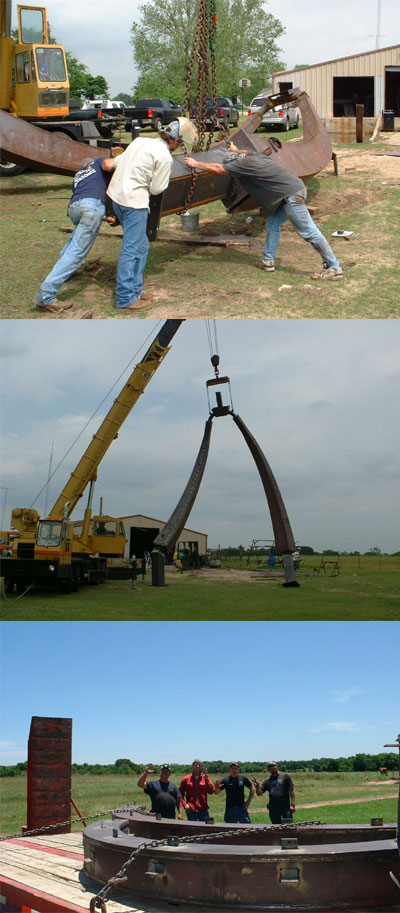|
|
 |
|
|
|
Fabrication of The Traveling Man
One fabrication challenge was how to bend 8-inch and 6-inch solid round bar into the positions required for the arms and pelvis. Engineering requirements dictated that the steel arms and legs, shaped like a trapeziodal box, were to fit precisely onto the solid round bar of steel. The team had to use a bulldozer tied onto the pelvis and hook a crane onto the end of the leg to create a strong pull. Three rosebud torches heated the bar to facilitate the bending as the bulldozer pulled from one end and the crane from the other. Working with steel pieces 26-feet-long was no simple task. Each leg had to be one continuous piece, while the bars for the shoulders and hips needed to be bent and fabricated to specific dimensions.
As work was underway on the skeleton, prep for the installation started for the three sites. With the ground cleared at Swiss and Good Latimer, McKinney Drilling Company drilled two 32-foot-deep piers for The Traveling Man-Walking Tall. The concrete and rebar piers provided a structurally sound base to support the steel bones of the sculpture.
Once the two legs for “Walking Tall” were on site, they were hoisted with cranes, at which point, the hips were welded in place. On-site welders, under the direction of Sam Cantu, put the final welds onto the zinc-coated steel bones. Many days of design and planning helped to reduce the amount of on-site welding that was required, and allowed for most of the work to be performed beforehand by Keith Ashmore’s team, in an atmosphere that was not rushed.
The brushed stainless steel 304 skin was cut and hand-bent into the general shape off-site. Once on-site, the artisans with LM Fabrication fined tuned the shape of each section and riveted the stainless steel panels in place. The BOII team worked along side LM Fabrication on this complicated and intricate installation of the skin. The stainless steel exterior work is detailed in the “Construction & Installation” segment as it comprised the bulk of the installation effort.
|
||
|
|
||